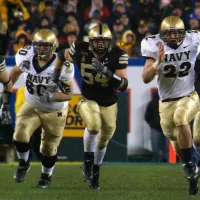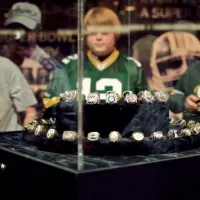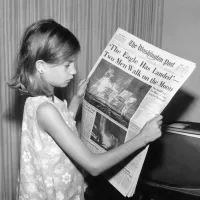Ohio is a Midwestern U.S. state bordering Lake Erie. It's the 34th-largest state by area and the 7th-most populous, with nearly 11.9 million residents. Columbus is the capital and largest city. Other major cities include Cleveland, Cincinnati, Dayton, Akron, and Toledo. Known as the "Buckeye State" after its Ohio buckeye trees, Ohio boasts a diverse economy and plays a significant role in U.S. history and culture.
May 17, 1901: Earthquake Near Portsmouth
On May 17, 1901, an earthquake of magnitude 4.2 occurred near Portsmouth, Ohio.
May 9, 1902: Ohio Officially Adopts State Flag
On May 9, 1902, the state legislature officially adopted the flag of Ohio.
December 17, 1903: Wright Brothers Invent First Successful Airplane
On December 17, 1903, Dayton natives Orville and Wilbur Wright successfully flew the first airplane at Kitty Hawk, North Carolina.
1910: Interior Canals Carry Bulk Freight
As late as 1910, interior canals in Ohio carried much of the bulk freight of the state.
1913: Great Flood of 1913
In 1913, Ohio experienced its greatest natural disaster with the Great Flood, causing at least 428 fatalities and hundreds of millions of dollars in property damage, particularly in the Great Miami River basin.
1913: Main Market Route 3 Chosen for Lincoln Highway in 1913
In 1913, one of the pioneer routes, known as "Main Market Route 3" in the early 20th century, was chosen to become part of the historic Lincoln Highway.
October 3, 1920: First NFL Game
On October 3, 1920, the first official National Football League (NFL) game took place when the Dayton Triangles defeated the Columbus Panhandles 14-0 in Dayton.
1922: NFL Championship for Bulldogs
In 1922, the Bulldogs won the NFL Championship.
1922: Origin of the Klondike Bar
The Klondike bar originated in Mansfield in 1922.
1923: NFL Championship for Bulldogs
In 1923, the Bulldogs won the NFL Championship.
1924: Production of Dum Dums Lollipops
Dum Dums lollipops were originally produced in Bellevue, Ohio in 1924.
1924: NFL Championship for Bulldogs
In 1924, the Bulldogs won the NFL Championship.
1926: Lincoln Highway Through Ohio Becomes U.S. Route 30 in 1926
Upon the advent of the federal numbered highway system in 1926, the Lincoln Highway through Ohio became U.S. Route 30.
1933: Great Depression Impact on Ohio
By 1933, during the Great Depression, over 40% of factory workers and 67% of construction workers in Ohio were unemployed. The state unemployment rate reached a high of 37.3%.
July 21, 1934: Highest Recorded Temperature
On July 21, 1934, the highest recorded temperature in Ohio was 113 °F (45 °C) near Gallipolis.
March 9, 1937: Anna (Shelby County) Earthquake
On March 9, 1937, the most substantial known earthquake in Ohio history, the Anna (Shelby County) earthquake, occurred with a magnitude of 5.4.
1940: Ohio's Population Growth
In 1940, Ohio's population growth experienced a slowdown compared to previous decades.
1944: Ohio Election Miss
Since 1896, Ohio has had only three misses in the general election.
1945: NFL Championship for Rams
In 1945, the Rams won the NFL Championship.
1950: NFL Championship for Browns
In 1950, the Browns won the NFL Championship.
1952: First Rock 'n' Roll Concert
In 1952, Alan Freed hosted the first live rock 'n' roll concert in Cleveland.
1953: Discovery of Oversight in Ohio Statehood Resolution
In 1953, as Ohio prepared to celebrate its sesquicentennial, it was discovered that Congress had not passed a formal resolution admitting Ohio as the 17th state. Congressman George H. Bender introduced a bill to admit Ohio to the Union retroactively to March 1, 1803.
1953: Spangler Candy Company and Dum Dums
Since 1953, Dum Dums lollipops have been made by Spangler Candy Company in Bryan, Ohio.
1954: NFL Championship for Browns
In 1954, the Browns won the NFL Championship.
1955: NFL Championship for Browns
In 1955, the Browns won the NFL Championship.
1960: Ohio Election Miss
Since 1896, Ohio has had only three misses in the general election.
1963: Pro Football Hall of Fame
Canton was enshrined as the home of the Pro Football Hall of Fame in 1963.
1963: Canton Enshrined as Home of Pro Football Hall of Fame
In 1963, Canton was enshrined as the home of the Pro Football Hall of Fame.
1964: NFL Championship for Browns
In 1964, the Browns won the NFL Championship.
1964: Ohio Voting Streak
Ohio began the longest perfect streak of any state, voting for the winning presidential candidate in each election from 1964 to 2016.
1965: Appalachian Regional Development Act
In 1965, Congress passed the Appalachian Regional Development Act to address poverty in the Appalachian Region, defining 29 Ohio counties as part of Appalachia.
1967: Carl Stokes Elected Mayor of Cleveland
In 1967, Carl Stokes was elected mayor of Cleveland, becoming the first African American mayor of one of the nation's 10 most populous cities.
1970: Kent State Shooting
In 1970, during an antiwar protest at Kent State University, an Ohio Army National Guard unit fired at students, killing four and wounding nine. The protests were largely in response to the United States' invasion of Cambodia during the Vietnam War.
1970: Ohio's Population Growth
In 1970, the census recorded just over 10.65 million Ohioans.
July 1979: State of Ohio Trade Mission to China
In July 1979, Ohio Governor Jim Rhodes led a State of Ohio Trade Mission to China, which resulted in developing economic ties, including a sister state-province relationship with Hubei province.
1979: Last Service to Columbus Union Station in 1979
Columbus' Union Station was last served in 1979 by the National Limited.
1980: U.S. Supreme Court Ruling on Ohio River Boundary
In 1980, the U.S. Supreme Court ruled that the boundary between Ohio and Kentucky (and West Virginia) is the northern low-water mark of the Ohio River as it existed in 1792.
1982: Grand Prix of Cleveland CART Races
The Grand Prix of Cleveland hosted CART races from 1982 to 2007.
1983: Winter Guard International Championships
Between 1983 and 2003, Winter Guard International hosted national championships in performing arts at the University of Dayton 18 times.
January 31, 1986: Earthquake in LeRoy Township
On January 31, 1986, an earthquake of 5.0 magnitude occurred in LeRoy Township in Lake County, Ohio, triggering aftershocks for two months.
1990: Ohio's Population Center
In 1990, Ohio's population center was located approximately 6,346 feet north and east of its location in 2000.
1990: Manufacturing Job Losses Begin
Starting in 1990, Ohio began to experience significant losses in manufacturing jobs as part of deindustrialization.
1993: National Voter Registration Act of 1993
In April 2016, a lawsuit was filed challenging Ohio's policy on the grounds that it violated the National Voter Registration Act (NVRA) of 1993.
1994: Ohio's Voter Purge Policy Since 1994
Since 1994, the state of Ohio has had a policy of purging infrequent voters from its rolls.
2000: Ohio's Population Center
As of 2000, Ohio's center of population was located in Morrow County, specifically in the county seat of Mount Gilead.
2000: Union Membership at 17.4%
In 2000, 17.4% of Ohioan workers were union members.
2002: Help America Vote Act of 2002
In April 2016, a lawsuit was filed challenging Ohio's policy on the grounds that it violated the Help America Vote Act of 2002.
2003: Winter Guard International Championships
Between 1983 and 2003, Winter Guard International hosted national championships in performing arts at the University of Dayton 18 times.
2005: Winter Guard International Championships
Since 2005, Winter Guard International has permanently hosted national championships in performing arts at the University of Dayton.
2006: Drop in Median Household Income
From 2006-07 to 2008-09, the median household income in Ohio dropped 7%.
December 2007: Job Losses Begin
Starting in December 2007, Ohio began to experience significant job losses during the Great Recession.
2007: Grand Prix of Cleveland CART Races
The Grand Prix of Cleveland hosted CART races from 1982 to 2007.
2007: Ohio's Economy Pre-Recession
The state of Ohio still lacked 45,000 jobs compared to the pre-recession numbers of 2007.
2008: Ohio's Top Companies
In 2008, fifty-nine of the United States' top 1,000 publicly traded companies (by revenue) were headquartered in Ohio, including Procter & Gamble, Goodyear Tire & Rubber, AK Steel, Timken, Abercrombie & Fitch, and Wendy's.
2008: Unemployment Rate Increase
In the first two months of 2008, Ohio's unemployment rate rose to 5.6% as the Great Recession began.
December 2009: Peak Unemployment Rate
In December 2009, Ohio's unemployment rate peaked at 11.1% during the Great Recession.
2009: Income Growth in Ohio
Ohio's overall income grew in Ohio from 2009 to 2012.
January 2010: Peak Unemployment Rate
In January 2010, Ohio's unemployment rate remained at a peak of 11.1% during the Great Recession.
May 2010: Ohio's Unemployment Rate
In May 2010, Ohio's unemployment rate was at 10.7%.
September 2010: Significant Job Losses
From December 2007 to September 2010, Ohio lost 376,500 jobs during the Great Recession.
2010: Languages Spoken in Ohio
According to the 2010 census, about 6.7% of Ohio's population age 5 years and older reported speaking a language other than English. Ohio also had the nation's largest population of Slovene speakers, second largest of Slovak speakers, second largest of Pennsylvania Dutch (German) speakers, and the third largest of Serbian speakers.
2010: Religious Denominations in Ohio
According to the ARDA, in 2010 the largest Christian denominations by adherents were the Catholic Church; the United Methodist Church; the Evangelical Lutheran Church in America with; the Southern Baptist Convention; the Christian Churches and Churches of Christ; the United Church of Christ; and the Presbyterian Church (USA).
2010: "Third Frontier" Program Impact
As of 2010, the Ohio Department of Development attributed the creation of 9,500 jobs to the "Third Frontier" program, with an average salary of $65,000, and a $6.6 billion economic impact.
2010: Ohio Business Climate Ranking
In 2010, Ohio was ranked second in the country for best business climate by Site Selection magazine, based on a business-activity database.
2010: Ohio's Population Growth
In 2010, the United States census recorded an increase in Ohio's population, although the growth lagged behind that of the entire United States.
2010: Ohio Voter Demographic
Since the 2010 midterm elections, Ohio's voter demographic has leaned towards the Republican Party.
2011: Ohio's Population Demographics
As of 2011, 27.6% of Ohio's children under the age of 1 belonged to minority groups, while females made up an estimated 51.2% of the population.
December 31, 2011: Earthquake Near Youngstown
On December 31, 2011, an earthquake occurred approximately 4 kilometers (2.5 mi) northwest of Youngstown, Ohio, registering a 4.0 magnitude.
2012: Income Inequality in Ohio
From 2009 to 2012 the top 1% in Ohio had a 37.0% in income growth, while the bottom 99% grew their income by only 2.3%.
August 2014: Unemployment Rate Returns to 5.6%
By August 2014, Ohio's unemployment rate returned to 5.6%, the same rate as before the Great Recession.
2014: Importance of Religion in Ohio
According to a Pew Forum poll in 2014, 56% of Ohioans felt religion was "very important", 25% felt it was "somewhat important", and 19% felt it was "not too important/not important at all".
April 2015: Labor Force Participation in Ohio
As of April 2015, the labor force participation in Ohio was 63%, slightly above the national average.
2015: Ohio GDP
By 2015, Ohio's gross domestic product was $608.1 billion.
April 2016: Lawsuit Filed Against Ohio's Voter Purge Policy in April 2016
In April 2016, a lawsuit was filed challenging Ohio's policy of purging infrequent voters, alleging it violated the National Voter Registration Act (NVRA) of 1993 and the Help America Vote Act of 2002.
November 2016: Preliminary Injunction Upheld for November 2016 Election
In November 2016, a federal district court ruled for the plaintiffs and entered a preliminary injunction applicable only to the November 2016 election to prevent the purging of voters from the rolls.
2016: Ohio's Gross Domestic Product
In 2016, Ohio's gross domestic product (GDP) was $626 billion, ranking the state's economy as the seventh-largest among all 50 states and Washington, D.C.
2016: Cleveland Cavaliers NBA Championship
In 2016, the Cleveland Cavaliers won the NBA Championship.
2016: Ohio Votes for Donald Trump
Ohio voted for Republican Donald Trump at larger margins than the nation as a whole in the 2016 presidential election.
February 2018: Ohio's Unemployment Rate
As of February 2018, Ohio's unemployment rate stood at 4.5%.
2018: Income Tax Burden in Ohio
In 2018, the bottom 20% of earners in Ohio contributed 12.3% of their income towards various taxes, while the top 1% only paid 6.5%.
June 10, 2019: Earthquake Near Eastlake
On June 10, 2019, an earthquake occurred approximately 5 kilometers (3.1 mi) north-northwest of Eastlake under Lake Erie, Ohio, registering a 4.0 magnitude.
2019: Manufacturing Job Losses Continue
By 2019, Ohio had lost over 300,000 manufacturing jobs since 1990 but had added over 1,000,000 non-manufacturing jobs.
2019: Columbus Corporations on U.S. Fortune 500 List
In 2019, Columbus had six corporations named to the U.S. Fortune 500 list: Alliance Data, Nationwide Mutual Insurance Company, American Electric Power, L Brands, Huntington Bancshares, and Cardinal Health.
2019: Ohio Ranks Seventh in GDP
In 2019, Ohio ranked seventh in GDP among US states, maintaining its status as an industrial state with the third-largest manufacturing sector and second-largest automobile production.
March 9, 2020: COVID-19 Pandemic Reaches Ohio
On March 9, 2020, the COVID-19 pandemic reached Ohio, with three cases reported.
2020: Religious Denominations in Ohio
According to the ARDA's 2020 study, Non-denominational Christianity was the largest Protestant cohort, while Catholicism remained the single-largest denomination. Ohio had the second largest Amish population of all U.S. states.
2020: Ohio Lottery Contributions to Education
As of 2020, the Ohio Lottery has contributed more than $26 billion to education since 1974.
2020: Ohio's U.S. House Seats Following the 2020 Census
Following the 2020 census, Ohio has 15 seats in the U.S. House of Representatives.
2020: Ohio's Population Growth
In 2020, the United States Census Bureau counted 11,808,848 Ohioans, a 2.4% increase since 2010.
2020: Ohio's Voting Hardship Ranking in 2020
In a 2020 study, Ohio was ranked as the 17th hardest state for citizens to vote in.
2020: Ohio Votes for Donald Trump
Ohio voted for Republican Donald Trump at larger margins than the nation as a whole in the 2020 presidential election.
2021: Religious Affiliation in Ohio
According to the Public Religion Research Institute's 2021 American Values Survey, 64% of Ohioans identified as Christian, while roughly 30% were unaffiliated with any religious body.
2022: Homeless Population in Ohio
According to HUD's 2022 Annual Homeless Assessment Report, there were an estimated 10,654 homeless people in Ohio.
2022: Ohio General Assembly
As of the 2022 election cycle, the Republican Party is the majority party in both houses of the Ohio General Assembly.
2022: Union Membership at 12.8%
By 2022, 12.8% of Ohioan workers were union members.
2022: Cincinnati Bearcats Football Playoff Qualification
In 2022, the Bearcats football team became the first "Group of Five" team to qualify to the College Football Playoff.
February 2023: COVID-19 Deaths
As of February 2023, over 41,600 Ohioans have died from COVID-19.
2023: Employment and Establishments in Ohio
According to the U.S. Census Bureau, the total number of people employed in 2023 was 5,081,279.
2023: Ohio's Income and Poverty
As of 2023, Ohio's per capita income was $60,402, and the state's median household income was $65,720. Also in 2023, 13.4% of the population was living below the poverty line.
2023: Ohioans Approve Abortion Rights Amendment in 2023
In 2023, Ohioans approved a constitutional amendment strengthening abortion rights.
2024: Ohio State Buckeyes Football Record
As of 2024, the Ohio State Buckeyes football team has a 977–335–53 overall record and a 30–29 bowl record.
2024: Ohio Voters
As of 2024, there are more than 8 million registered Ohioan voters, of which over 70% are not affiliated with any political party.
2024: Ohio's Federal Representatives in 2024
As of the 2024 election cycle, ten federal representatives are Republicans while five are Democrats in Ohio.
2024: Ohio Votes for Donald Trump
Ohio voted for Republican Donald Trump at larger margins than the nation as a whole in the 2024 presidential election.
Mentioned in this timeline

Donald John Trump is an American politician media personality and...

College football is a popular amateur sport in the United...
India officially the Republic of India is a South Asian...

The Catholic Church the largest Christian church globally with over...

The Super Bowl is the annual championship game of the...

News encompasses information about current events disseminated through various media...
Trending

2 months ago Dubai Overtakes New York as Top Destination for the World's Wealthy Elite.
Gaten Matarazzo is an American actor known for his stage and screen work He started his career on Broadway appearing...

2 months ago Kendall Jenner Celebrates Her 30th Birthday with Nude Beach Photos and Bikini Looks

6 months ago John Wall's NBA Return Celebrated, DeMarcus Cousins Adds Humor, Fans Show Love.
23 days ago Druski's comedy: Viral video, 'hatfishing' skit, and hosting Billboard 2025 livestream.

3 months ago Sam Altman Envies Gen Z Dropouts' Startup Opportunities: A Generational Perspective on Education.
Popular

XXXTentacion born Jahseh Dwayne Ricardo Onfroy was a controversial yet...

Ben Shapiro is a prominent American conservative political commentator media...

Candace Owens is an American conservative political commentator and author...

Stranger Things created by the Duffer Brothers is a popular...

William Franklin Graham III commonly known as Franklin Graham is...
The Kennedy Center Honors are annual awards recognizing individuals and...